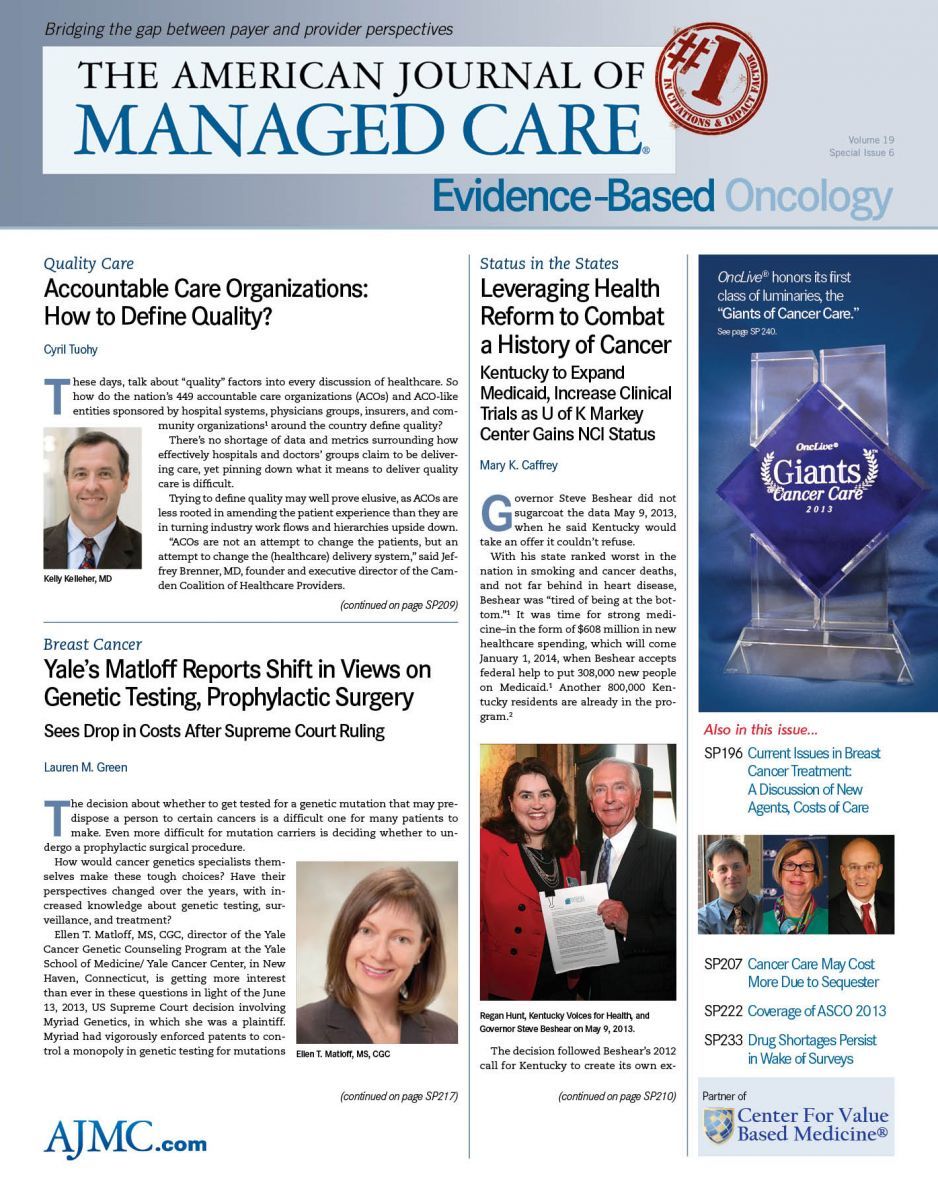- Center on Health Equity & Access
- Clinical
- Health Care Cost
- Health Care Delivery
- Insurance
- Policy
- Technology
- Value-Based Care
For Partners of HPV-Positive Throat Cancer Patients, Good News in Studies
Patients with human papilloma virus—positive oropharyngeal cancer (HPV-OPC) and their spouses may find some reassurance in a recent study by researchers at the Johns Hopkins Bloomberg School of Health. The study found that partners are no more likely to be infected by HPV than the general population, and their risk of contracting HPV-OPC remains low.
Findings of this pilot study—the first large study to examine oral HPV infection among patients with HPV-OPC and their partners—were announced in a press briefing at the 2013 ASCO Annual Meeting. The majority of oropharyngeal cancers in the United States are now caused by HPV, and the incidence of HPV-related oropharyngeal cancer is increasing significantly, noted the study’s lead author, Gypsyamber D’Souza, PhD, MPH, MS, associate professor of Epidemiology at the Johns Hopkins Bloomberg School of Public Health in Baltimore, Maryland.
“Some of the patients with this diagnosis worry about oral HPV transmission and the cancer risk to their partners or spouses.” To better understand this possible increased risk, D’Souza and colleagues enrolled a total of 166 patients with HPV-OPC; 94 of them had spouses or long-term partners who were also enrolled in the study. DNA samples were collected from both groups, following administration of a 30-second mouth rinse and gargle. Samples were obtained at the time of diagnosis and 1 year later.
Median age of the HPV-OPC patients was 56 years; 89% were male, 92% were white, non-Hispanic, and 94% had performed oral sex. Their partners were predominantly female (94%) and white, non-Hispanic (92%), with a median age of 53 years. Patients were significantly more likely to have had >10 oral sex partners over their lifetime (39%), versus their spouses/partners (11%). Samples were analyzed for the presence of 36 subtypes of HPV DNA, among them, the most prevalent type found in the majority of HPV-OPC cancers—HPV16.
DNA is considered the “gold standard” for determining presence of HPV in the tumor, D’Souza explained. She noted that for individuals without cancer, examining exfoliated oral cells from the rinse/gargle samples is the best available option for measuring oral HPV infection, since there is currently no validated, US Food and Drug Administration-approved test. Researchers found that nearly two-thirds of the cases (65%) had HPV DNA in their oral exfoliated cells, and a little over half (54%) of these cases had HPV16, said D’Souza. After 1 year and completion of treatment, analysis of the oral rinse samples from the HPVOPC cases demonstrated that a “vast majority of these cases no longer had any HPV16 DNA detectable,” she added.
The prevalence of HPV among the long-term female partners of patients was 5%, which is comparable to the 4% prevalence among women in the general population, based on previously published data. HPV16 was found in just 2.3% of female partners and in none of the small number of male partners. In addition, no precancers or cancers were detected in the 60 partners/spouses who underwent a visual oral exam.
“These findings provide assurance that prevalence of oral HPV infection is not increased among partners [of patients with HPV-OPC], and their risk of HPV-OPC remains low,” said D’Souza. “Couples who have been together for several years have likely shared whatever infections they have, and no changes in their physical intimacy are needed.”
D’Souza concluded her presentation by noting that while oral HPV infection remains common, “many individuals who become infected are able to clear these infections and not get cancer.” “HPV is responsible for thousands of cases of cancer of the oropharynx, cervix, and other sites every year,” noted Gregory Masters, MD, ASCO spokesperson and moderator of the press briefing. “This study improves our understanding of HPV risk among the partners of patients with HPV-positive oropharyngeal cancers. I’m sure this news will provide long-awaited reassurance for patients, as well as their spouses and partners.” 1. D’Souza G, Gross ND, Pai SI, et al. Oral HPV infection in HPV-positive oropharyngeal cancer cases and their spouses. J Clin Oncol. 2013;31

HEDIS Glycemic Goal Achieved Using Control-IQ Technology
December 22nd 2025A greater proportion of patients with type 1 diabetes who used automated insulin delivery systems vs multiple daily injections achieved the Healthcare Effectiveness Data and Information Set (HEDIS) glycemic measure.
Read More
Linking Data to Determine Risk for 30-Day Readmissions in Dementia
December 22nd 2025This study found that certain characteristics in linked electronic health record data across episodes of care can help identify patients with Alzheimer disease and related dementias at high risk of 30-day readmissions.
Read More
Performance of 2-Stage Health-Related Social Needs Screening Using Area-Level Measures
December 19th 2025Limiting health-related social needs screening to lower-income areas would reduce screening burdens; however, this study found a 2-stage screening approach based on geography to be suboptimal.
Read More
Impact of Medicaid Institution for Mental Diseases Exclusion on Serious Mental Illness Outcomes
December 17th 2025Medicaid’s Institution for Mental Diseases (IMD) rule bars federal funding for psychiatric facilities with more than 16 beds, but findings indicate that state waivers allowing treatment of serious mental illness in IMDs do not increase overall psychiatric hospitalizations.
Read More
Physician-Pharmacy Integration in Cancer Care: Pillars of Medically Integrated Pharmacy
December 16th 2025The foundation of medically integrated pharmacy includes 7 critical pillars. This commentary focuses on the benefits of 3 of those pillars: abandonment, adherence, and access/affordability.
Read More

